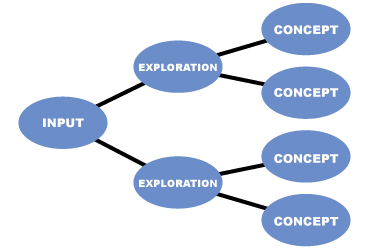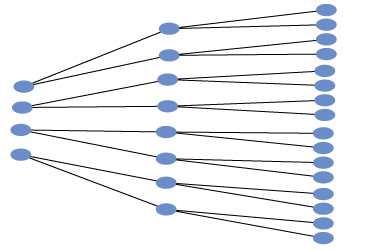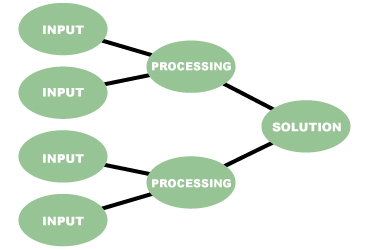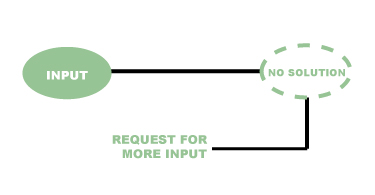Delta Thought Patterns: The difference between creative and technical minds
June 8, 2010

[This article concentrates on creative and technical individuals within an IT environment, but the theory can easily be applied to many other scenarios.]
Due to the simplicity of its underlying architecture, the early world wide web polarised form and function – websites were either works of art or performed some form of technical functionality.
With the advances that have now been achieved, graphically rich websites no longer have to merely be animated artworks, simply to be viewed without actually achieving anything.
Similarly, technical web-based applications are no longer confined to the realms of clunky-looking technical dialogues in a single shade of insipid grey.
One result this cross-pollination has had is in blurring the roles of teams that produce web-based content. Design agencies are increasingly having to deliver technical aspects within the solutions they provide and IT firms are having to add a creative string to their bows in order to meet the expanded expectations of today’s clients.
Managers and team leaders, used to overseeing a purely technical or creative group of expertise, now have to supervise and nurture a cell comprising multiple disciplines.
In most cases, the individual overseeing the group will have a background solely in a technical or creative environment. The challenge to the team leader is not simply to view their newly expanded team as numerically larger, but to appreciate the different needs within the group without introducing potentially damaging segregation.
Passed the same stimulus, the creative and technical mind will analyse and process the information in significantly different ways. Understanding the difference between these two mindsets will enable the team leader to avoid communication issues and utilise each member of the group to their full potential.
This is not to say that technically-minded individuals are incapable of creativity or that creative people cannot perform technical problem solving. Technical experts often need to think creatively when finding the answer to a particularly tricky issue. Creative artists also require technical ability in order to produce the visual output required of them.
There also exists that rare creature who spans both worlds and is able to be technically brilliant while very artistic.
But the majority of people working at the web’s coal face will either be of a creative focus or a technical focus, and the role and function that they excel in demands that the way in which they perceive input is the complete reversal of the other discipline.
Thinking of the single threads within a thought process as rivers, two distinct delta patterns can be applied to problem solving.
Divergent delta thinking (the creative mind)
This thought model takes a single strand of thought and then splits it into multiple new streams, all based upon the original concept. These new strands can also then diverge into an ever-expanding series of parallel thought streams.

A delivery company seeking a new logo will expect the designer to produce a range of options to choose from and will want all of these options to be distinct from their competitors and yet still encapsulate the concept of fast and secure delivery.
And when a second delivery company approaches the designer for a logo, then a whole new set of options will be expected that are different again, despite the identical requirement.
A writer of crime fiction telling a story of a detective solving a murder will be expected to produce a different plot to their previous works and also distinct from all other murder mystery novels that have preceded it.
Although there are times when the creative process produces convergence (a company will whittle down to one final logo, a novel will only have one ending) the majority of the time the creative mind is taking small amounts of material and expanding multiple concepts out of very minimal input.
The creative mind, provided with an image that has too much of the detail filled in, will simply expand the canvas at the edge in order to have room to explore and explode the concept further.
More often than not in web projects, the creative resources are brought in at the end as an afterthought, to ‘pretty things up.’ But creative minds do not just work well on visual aesthetics and can function just as well on exploring all manner of concepts and finding ideas from left of field that would have been left otherwise unexplored.

When presented with an almost complete project (or too much directive input), the creative mind will either start re-exploring the finalised concepts in order to put their creative mind to work or simply shrug and walk away from the project, pointing out that the project is almost complete and so there is little of value they can offer.
Convergent delta thinking (the technical mind)
Here a wide range of separate streams converge and keep meeting until there are the minimal number of streams possible (ideally one single stream.)

The technical mind seeks simplicity and efficiency. This is not to say that a technical mind is not capable of complexity. On the contrary, it needs to understand a vast amount of overlapping detail in order for its refining process to work as well as it does.
The technical mind seeks to understand all the details of a problem in order to produce the most simple and logical solution that will satisfy all requirements.
If a single part of the solution can be configured to solve five parts of the problem then efficiency dictates that this is more productive than producing five separate (yet similar) parts to meet the five almost identical problems.
The technical mind likes to componentise solutions so that a single part can be used multiple times within a project, but also so that this component might be reused for similar problems in future projects, rather than having to produce exactly the same code afresh when it is required at a later date.
Once again, just as the creative mind can be convergent, there are also instances of divergence in the technical thought process. A range of solutions may be carefully weighed before a single option is selected for a particular need. But, for the majority of the time, the technical mind is seeking to take vast issues of complexity and refine them down to the simplest form possible.
Just as a creative mind will be hamstrung by too much input, so a technical mind will not perform at its best when presented with too little information at the beginning of a project.

If not enough clear information is delivered for a technical mind to process and filter then the likely outcome will be that the brief is returned to the originator with a request for more details, or with a huge list of questions of attached.
The solution
Most IT companies do projects backwards. Technical people are brought in to question a client over their needs and will then write up a technical specification based upon this information.
A near finished system is then handed over to the creative department to have ‘a pretty face painted on it.’
The problem is that many clients are not fully aware of what solution they require and so there are often delays induced as the technical team go through a cycle of question and answer sessions until sufficient information has been extracted from the client for them to process.
Once companies begin to recognise both their creative and technical staff as the great thinkers they all are, and not just as UI painters and programmers, then a revolution in project efficiency is possible.
Creative minds need very little input to get working on a project and so brining them in upfront to extract information from the client can cut down on the Q&A cycles that are needed to extract enough information to produce a technical specification.
The creative mind can take the most vague of briefs and explode this out multiple times until a vast amount of concepts have been created without further input from the client. The client can then review the concepts from the creative department and simply cut out anything not needed rather than have to think up new ideas on a blank sheet of paper.
This cuts down on the amount of communication needed with the client before a project can commence and so reduces unnecessary delay. Obviously clear communication with a client is paramount throughout the lifecycle of any project to ensure the project is delivering the right solution. But often a client needs outside assistance in fully formulating the exact needs of a project and utilising creative thinking can be a powerful way of expanding the details of a solution quickly.
Once the full brief has been created, the technical team can then review the output, consolidating areas of overlap and flagging up any superfluous areas that are likely to create technical hurdles.

A round of interaction between the creative (blue) and technical teams (green) will then refine the details until the final solution is ready to be built.
While the technical team are finishing and testing the build, the creative team will already be out (alongside the sales people and project managers) and talking with the next client.
Creative and technical thought processes go far beyond visual ideas and problem solving in programming. Once companies grasp the fact that these thought patterns can be applied to all situations that their business face then their staff can be used to their maximum advantage.
Forget about the situation being a creative problem or a technical issue and start considering whether a situation needs expanding/exploring or refining/resolving and the right people will end up tackling the right tasks.